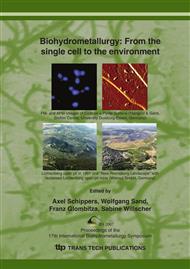p.167
p.168
p.170
p.171
p.172
p.177
p.189
p.193
p.197
Study on Selective Depression of Pyrite during Copper Bioleaching
Abstract:
During Zijinshan copper heap bioleaching, pyrite was leached in plenty resulting in high ferric concentration in solution. This affected bioleaching and extraction processing greatly. The paper studied the factors influencing in the course of leaching of pyrite and a mixture of chalcocite and pyrite respectively. It focuses on the effect of the redox potential for copper bioleaching so as to find key factors affecting the dissolution difference between chalcocite and pyrite. The experiment results showed that redox potential is an important influencing factor in bioleaching. Copper and pyrite extents of the leaching process were 95% and 11% respectively and there is great dissolution difference between them at redox potential 700 mV (SHE). It is indicated that copper can be selectively bioleached by controlling redox potential of bioleaching. The conclusion will provide theoretic foundation on balance of acid and iron during bioleaching for copper of higher S/Cu ratio. A simple sulfide, pyrite and chalcocite, were selected as test minerals. The samples were obtained from rich mineral in Zijin Mine. The concentrated samples were milled to obtain the size fraction of 320 mesh percent of 90. Bacterium culture: 9K culture medium contained the following composition in kg/m3 distilled water: (NH4)2SO4, 3.0; K2HPO4·3H2O, 0.5; KCl, 0.1; MgSO4·7H2O, 0.5; Ca(NO3)2·2H2O, 0.01. The initial ferrous concentration was 9.0g/L, the initial pH was adjusted to 1.6, and the temperature set at 30°C. The rotation speed of shaking bed was 150r/min. A three-day-old inoculum previously grown in medium was used in bioleaching process. A 5% inoculum was added to give an initial bacteria concentration in the medium was (3-6)×107 cells/m3. The experiments investigated factors influencing bioleaching including ferrous concentration and redox potential during bioleaching. The extent Cu leached was over 90%. Cu leached velocity increased as redox potential turned higher. Cu leached velocity rapid increased at redox potential 700mV. During chalcocite and pyrite bioleaching, redox potential is important factor to influence of bioleaching rate and the results showed that pyrite and chalcocite bioleaching rate was correlated with redox potential. It is indicated that copper can be selectively bioleached during copper bioleaching by controlling redox potential of bioleaching. It can be concluded that: (1) Pyrite and chalcocite bioleaching rate was correlated with redox potential. Redox potential was shown to be the key factor affecting the dissolution difference between chalcocite and pyrite. (2) Chalcocite and pyrite leaching efficiency were 95% and 11% respectively and there is great dissolution difference between them at redox potential 700 mV (SHE). (3) It is indicated that copper can be selectively bioleached during copper bioleaching by controlling redox potential of bioleaching.
Info:
Periodical:
Pages:
172-173
Citation:
Online since:
July 2007
Authors:
Keywords:
Price:
Сopyright:
© 2007 Trans Tech Publications Ltd. All Rights Reserved
Share:
Citation:


